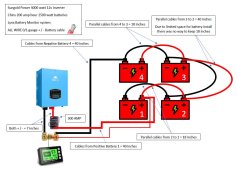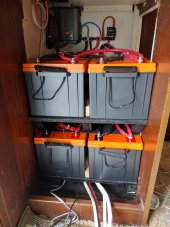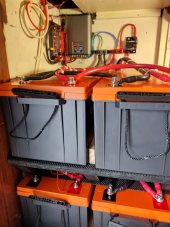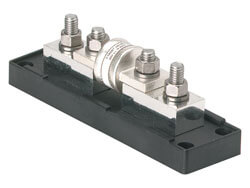I posted an issue with my four 200ah Chins batteries where when I place a heavy load like a microwave that my battery bank is shutting off. I received some great responses and made some adjustments to my wiring in hopes of resolving the issue. After making my modification I am still having the same problem. I am attaching a diagram of my build for anyone to look over and critique my wiring or any other possible issues, or do I have it correct?
My next question is does anyone know how many cells are in the case? If I have a BMS issue, I was thinking about cutting my batteries open and separating them from their cases and removing the Chins BMS and using an overkill BMS. Would this be an issue?
My installation area in my boat is pretty well protected in the living room. However space is an issue. I am thinking that I can get all the battery packs aligned better by removing them from the case and using a better BMS may solve my load issue. I know that returning them is the proper option, however I already have my boat in an off grid configuration and would have to rewire everything to run off generator power again while waiting on new batteries to arrive. This is my reasoning for not sending them back regardless of warranty (if I can keep from it).
I am attaching a couple of images taken PRIOR to rewiring to show my space limitations. So before ripping me a new one, remember the actual images of the batteries were before correcting wire lengths and positive and negative leads
I understand 12v but LifePo4 is a new learning curve. Thanks to Mr. Prowse and the people on this Forum I am learning.
Thank you all for your input and knowledge
D
My next question is does anyone know how many cells are in the case? If I have a BMS issue, I was thinking about cutting my batteries open and separating them from their cases and removing the Chins BMS and using an overkill BMS. Would this be an issue?
My installation area in my boat is pretty well protected in the living room. However space is an issue. I am thinking that I can get all the battery packs aligned better by removing them from the case and using a better BMS may solve my load issue. I know that returning them is the proper option, however I already have my boat in an off grid configuration and would have to rewire everything to run off generator power again while waiting on new batteries to arrive. This is my reasoning for not sending them back regardless of warranty (if I can keep from it).
I am attaching a couple of images taken PRIOR to rewiring to show my space limitations. So before ripping me a new one, remember the actual images of the batteries were before correcting wire lengths and positive and negative leads
I understand 12v but LifePo4 is a new learning curve. Thanks to Mr. Prowse and the people on this Forum I am learning.
Thank you all for your input and knowledge
D







